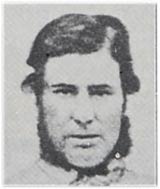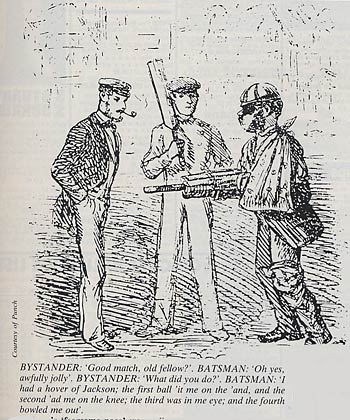RD Woodall traces the career of John `Foghorn' Jackson, once the fastest bowler in the land, who ended his days in a Liverpool Workhouse ...

|

John Jackson in his pomp
© Getty Images
|
|
John Jackson was probably the most formidable cricketer who played for Nottinghamshire in the nineteenth century. Jackson, a native of Bungay in Suffolk, was the best fast bowler of his day. When he was very young, his parents moved from Suffolk into Nottinghamshire to live near Newark. Sport was in his blood and he is said to have run barefoot after the hounds in the hunting field. He learned how to play cricket well at Southwell and his skill as a cricketer attracted the attention of local gentry who were the backbone of English teams of the day. He got work as a professional first with a Newark team. Later, after experience as a professional at Edinburgh and Ipswich, Jackson was engaged to serve in the Nottinghamshire Eleven.
In the ten years he was with the Nottinghamshire team his name was a household word and Jackson was subject of some of the best cartoons by John Leech for Punch, then very much an organ of humour for the better off. Leech was good at showing the expressions of village cricketers and the extent of their injuries after they came up against the lightning deliveries Jackson was famous for.
Jackson first appeared at Lord's in a match between North and South in 1856. In 1857 he was recognised as the most prominent bowler in England, when in the North versus South match he took eight wickets for 20 runs. By then, those who came up against him had a fair idea of what to expect. In 1858, when helping in the Kent versus England match, Jackson excelled himself by taking nine wickets for 27 runs at Lord's. In another match at Canterbury he took 13 wickets for 90 runs.
In Jackson's day scores were rarely very high and his highest batting score in firstclass cricket was 100 in the Nottinghamshire versus Kent match of 1863.
Between 1857 and 1864 Jackson played in 13 matches for the Players versus the Gentlemen and in a match at Lord's in 1861 he and another famous player of the day, Edgar Willsher, bowled unchanged through both innings of the Gentlemen.

|

The first-ever cartoon on cricket published in Punchin August 1863 featured John Jackson as its subject
© Getty Images
|
|
In Jackson's day international cricket was in its infancy and it was regarded almost as a revolutionary step when English teams began to play teams from other countries. In 1859 Jackson was a member of the first English team which went to North America. It achieved phenomenal success in playing American teams and helped to create a body of goodwill which survived the American Civil war.
Although matches with United States teams were impossible during the period of the Civil War between 1861 and 1865, matches in Australia were not. Jackson was a member of George Parr's All England Eleven, when it went to Australia in the winter of 1863. Jackson was still in his prime when his career as a cricketer was virtually finished by a leg injury he received playing for Nottinghamshire against Yorkshire.
From then on his story was really a tragic one. Unlike many professionals of today who have businesses to fall back on in bad times, he had not. From 1870 he lived mainly in Liverpool. From 1870 till 1872 he was the professional at Princes Park and in 1871 acted as caterer, groundsman and bowler to the Liverpool Club. His injury prevented a successful come back. In 1874 he received £300 from his Notts benefit match, but he drank it all away and by 1875 Jackson was working in a Liverpool warehouse.
Six feet tall and weighing over 15 stone, in his heyday he was a first class round-arm bowler with an easy action and a tremendous pace which earned him rightly the nickname of the "Demon Bowler". Had he lived in the 1920s or 1930s his figure, like that of Jack Hobbs or Herbert Sutcliffe, would have been on the cigarette cards.
Few came to help him in his old age, when he was in dire poverty. His genius was unknown to the generation of players, nationally famous, when he died in Liverpool Workhouse Infirmary on November 4, 1901. But for the injury which incapacitated him, Jackson might well have gone on playing successfully for a number of years more and ended his days as a successful instructor in a school, training the players of the future.



